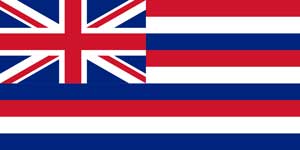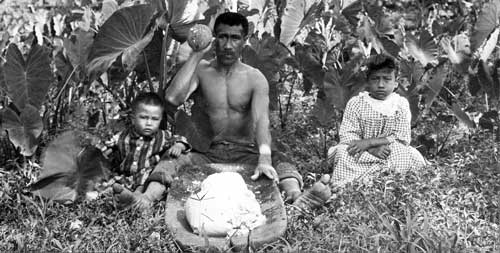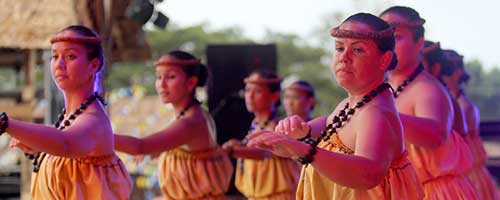Map
Flag

Quick facts
Official Name: Hawai’i
Indigenous Peoples: Kānaka maoli
Official Languages: Hawaiian and English
Political Status: US state
Capital: Honolulu, Oahu
Population: 1,419,561 (2014 US Census est.), 23% (326,499) of whom are native Hawaiian (Kānaka maoli)
Greeting: Aloha
History and geography

Hawai’i encompasses nearly the entire volcanic Hawaiian archipelago, which is comprised of hundreds of islands spread over 1,500 mi (2,400 km). At the southeastern end of the archipelago, the eight main islands are (in order from northwest to southeast): Niʻihau, Kauaʻi, Oʻahu, Molokaʻi, Lānaʻi, Kahoʻolawe, Maui and the Island of Hawai’i. The last is the largest island in the group; it is often called the “Big Island” or “Hawai’i Island” to avoid confusion with the state or archipelago.
The Hawai’ian Islands were formed by volcanic activity from under the sea. The process is continuing to build islands; the tectonic plate beneath much of the Pacific Ocean continually moves northwest and the hot spot remains stationary, slowly creating new volcanoes. Because of the hotspot’s location, all currently active land volcanoes are located on the southern half of Hawai’i Island. The newest volcano, Lōʻihi Seamount, is located south of the coast of Hawai’i Island.
The original inhabitants of these islands are believed to have come from the Marquesas and Tahiti, starting as early as 1,500 years ago. There is also oral tradition of early interaction with Samoa, and of Hawai’i being an origin of some of the early Maori emigrants to Aotearoa (New Zealand). Native Hawai’ian culture flourished over the centuries, giving rise to the art of the hula and the sport of surfing, but conflicts over land were common between ruling chieftains.
British Captain James Cook is credited with being the first European to land in Hawai’i in 1787, although some oral traditions and scholars hold that the Spaniards — who first crossed the Pacific Ocean in 1522, and regularly crossed from Peru to the Philippines by the late 1500s — also made inadvertent landfall in Hawai’i, but never correctly mapped or claimed credit for their accomplishment. When Cook arrived, he was well received and some natives thought he might even be an incarnation of their god Lono, whose sign was white kapa or tapa cloth like the sails of Captain Cook’s ship. Cook was killed several months later by the Hawai’ians at Kealakekua Bay in Kona while trying to retrieve a long boat. He had named them the Sandwich Islands, in honor of the Earl of Sandwich.
In 1791, North Kohala-born Kamehameha united the warring factions of Hawai’i Island and went on to unify all of the Hawai’ian Islands into one royal kingdom in 1810. In 1819, less than a year after King Kamehameha’s death, his son, Liholiho (King Kamehameha II), along with his wife, Queen Kaahumanu, abolished the ancient kapu system, a codified system of laws that governed all facets of political and religious life and social interaction.
Before long the stream of Europeans visiting Hawai’i quickly grew, bringing trade and whaling. The first Christian missionaries arrived in 1820 and the people quickly converted.
In 1850 the Sandwich Islands kingdom made it possible for foreigners to own private property in Hawai’i, which, along with increasing international trade with America, gave rise to the sugar industry. The rapid depletion of the Hawai’ian population due to illnesses eventually led the sugar plantation owners to import contract laborers from China, Japan, Korea, the Philippines, Russia, Scandinavia, Portugal and the Azores, Europe and Puerto Rico, among other places. The descendants of those who stayed give Hawai’i its cosmopolitan population today.
Influential non-Hawai’ian businessmen deposed the last reigning Hawai’ian monarch, Queen Lili’uokalani, in 1893. In 1900, the US annexed Hawai’i, reportedly for the purpose of gaining the Pearl Harbor anchorage for its naval forces.
On 7 December 1941, the Japanese launched a surprise attack on Pearl Harbor on Oahu. Four years later, on 2 September 1945, Japan signed its unconditional surrender on the USS Battleship Missouri, which still rests in Pearl Harbor today. In 1959, Hawai’i became the 50th State of the United States.
Arts and culture

Hawai’i is notable for the hula, surfing, quilting, canoe-building, songs, and the ukulele.
